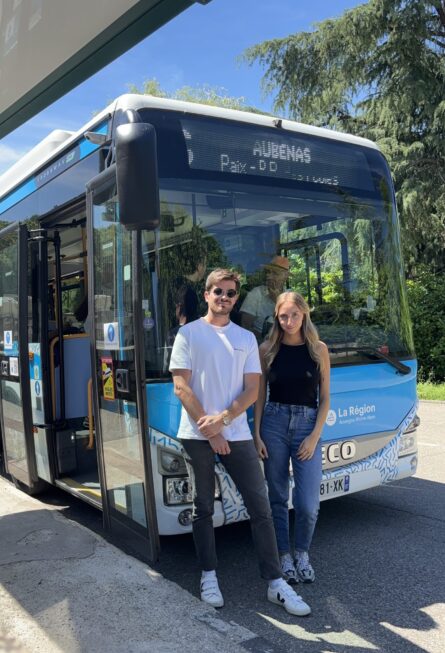
FEEDBACK FROM JOHAN DELEUZE, MANAGER OF THE TOUT’ENBUS NETWORK
Since 2007, Tout’enbus has been transforming mobility in Ardèche into a model of sustainable and efficient transport across the Communauté de Communes du Bassin d’Aubenas.
Responding to a growing demand for alternatives to car travel, the network was designed to improve local mobility while addressing the specific needs of residents. Johan oversaw the implementation of transport lines, administrative organization, and the integration of new technologies. The network has experienced steady growth and continuous service improvement, becoming a reference model for other communities.
Johan, can you introduce yourself ?
I’m Johan Deleuze, and I’ve been the manager of the Tout’enbus urban transport service since its creation in 2007.
Why did you choose to work in the field of mobility ?
With a master’s degree in spatial planning, I chose to return to Ardèche to contribute to local development. Urban planning and mobility have always been passions of mine, and in 2006, the oil crisis was a turning point — cars were becoming a luxury, and people were looking for alternatives. It was the right time to take action and offer practical, useful solutions to the people of Ardèche. Beyond tourism, there’s real everyday life here that needs support and progress.
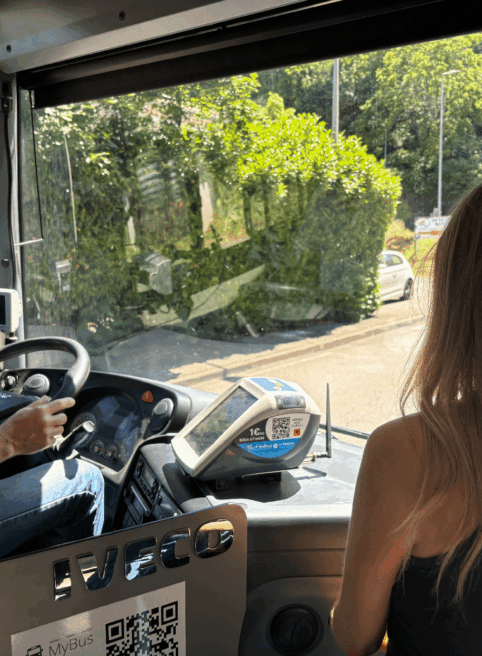
How do you design a transport service in Aubenas ?
I supervised the study, the organization, and the implementation of the transport service, taking into account both the routes and the administrative aspects. Thanks to my knowledge of the area and local travel patterns, we were able to quickly set up routes that matched the needs.
On the administrative side, we decided to create a dedicated transport authority with the support of the willing municipalities. The development of the network was based on a deep understanding of the territory its economy, housing, and mobility patterns with the aim of providing a smooth, efficient service without disrupting existing flows.
To the surprise of local officials, transportation clearly emerged as the top priority more so than expected services like a swimming pool or childcare facilities. It was widely assumed that everyone had easy access to transport, mostly by car, but that turned out not to be the case at all.
This led to the development of a detailed brief for an in-depth study on housing and mobility. Following the study’s findings, the local authorities decided to take further action by launching a comprehensive transport study across two intercommunal areas.
In 2007, the Communauté de Communes du Pays d’Aubenas-Vals launched a study on housing and transportation in response to a survey sent to 600 residents.
What was the context behind the creation of the mobility service ?
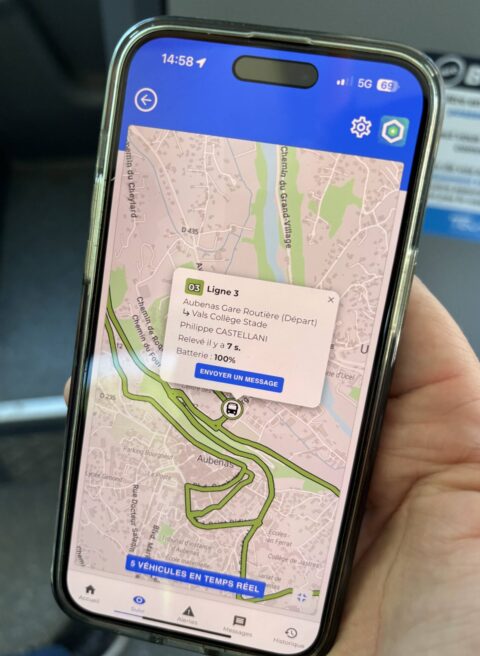
What impact did the 2017 changes and the 2019 Mobility Orientation Law have on the mobility service ?
In 2019, the Mobility Orientation Law (LOM) transferred mobility responsibilities to the Communities of Communes. However, the Communauté de Communes du Bassin d’Aubenas chose not to keep this responsibility for several reasons: it lacked sufficient staff structure, and managing transport across all the member municipalities would have significantly impacted its internal organization.
Thus, the Auvergne-Rhône-Alpes region became the new Mobility Organizing Authority. At the time, creating a joint syndicate combining several Communities of Communes and the Region was considered.
What were the initial reactions to the service ?
A two-year trial of the Tout’enbus network was launched with the department’s approval. After positive results, a transport syndicate was created in 2009 with six municipalities, and gradually expanded to eleven by 2019. At the same time, the mobility offer was broadened to include bike rentals, carpool parking areas, and a car-sharing service.
However, the tight deadlines imposed by the LOM law were too short, leading to the dissolution of the transport syndicate and the transfer of responsibility to the Region as the Mobility Organizing Authority (AOM).

So, is the region managing the Tout’enbus network ?
Yes and no. The region holds the mobility authority, but it chose to delegate the operational management of the service to the Communauté de Communes du Bassin d’Aubenas. This was formalized through a delegation agreement between the Region and the Communauté de Communes.
Basically, the region delegates the service management to the Communauté de Communes while continuing to fund it. On our side, we are regional agents assigned to the Communauté de Communes to handle this management.
What impact does the absence of a train station have on mobility ?
There is no longer a train station, but regional buses connect to Montélimar and Valence. The old railway lines have been converted into bike paths, supporting more sustainable mobility. This reflects a significant societal shift.
Can you describe the Communauté de Communes ?
Tout’enbus serves 11 urban and suburban municipalities around Aubenas, covering 35,000 of the 45,000 inhabitants in the entire Communauté de Communes. This densely populated area concentrates services, schools, and businesses. Choosing an urban transport offer was therefore relevant. Beyond transportation, the service also plays a strong social role by supporting vulnerable groups such as the elderly, young people, and those without a driver’s license.
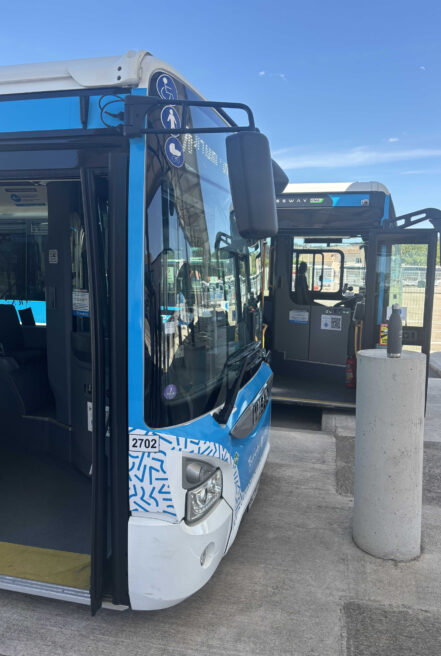
Beyond the greenways, what initiatives support sustainable mobility ?
We work on optimizing existing lines and creating new ones, considering environmental and urban challenges. The goal is a structured network focused on the most populated hubs, with main and secondary lines, and support for soft mobility options like cycling, walking, and carpooling. The bus remains the backbone of the system but needs to be complemented by other solutions. We’re also considering a frequent shuttle service between the train station and downtown to ease travel, improve coverage, and reduce traffic in the city center.
What changes have been made to welcome travelers since the service started ?
Various organizations are developing diverse mobility solutions. In Ardèche, it’s common for a single person to own two cars, which poses a real problem.
Why is that ?
Although cars remain the dominant mode of transport, many initiatives are emerging to diversify options, especially for those facing mobility challenges. For example, the association Mobilité 07-26 offers moped rentals, affordable solidarity driving licenses, and training on mobility options and costs. Other groups promote car-sharing, including electric vehicles available for rent, such as through the Communauté de Communes Privas Centre Ardèche. Some local associations specialize in bike repair, facilitating reuse.
These mobility forms complement the bus network. Their development requires better coordination: accommodating bikes on buses, increasing service near carpool parking lots, and improving interconnection between modes. The network has matured but must keep adapting to changes in housing, services, and travel habits to stay relevant and accessible.
How do you meet users’ needs with a limited budget ?
We focus on optimizing both the network and our resources. Of course, there are costs to conside it’s hard to justify maintaining routes that serve only one person per trip. For that passenger, it may seem unfair, but as a public service, our goal is to meet the needs of as many users as possible, within our means.
What role does passenger data play in optimizing the network ?
We use our ticketing system to track boardings. However, for passengers who pay daily, it's harder to know exactly who gets on board. To address this, Aurélien analyzes statistics on the 10 busiest boarding points. At the same time, I conduct field observations to listen to users and get a real understanding of what’s happening on the ground.
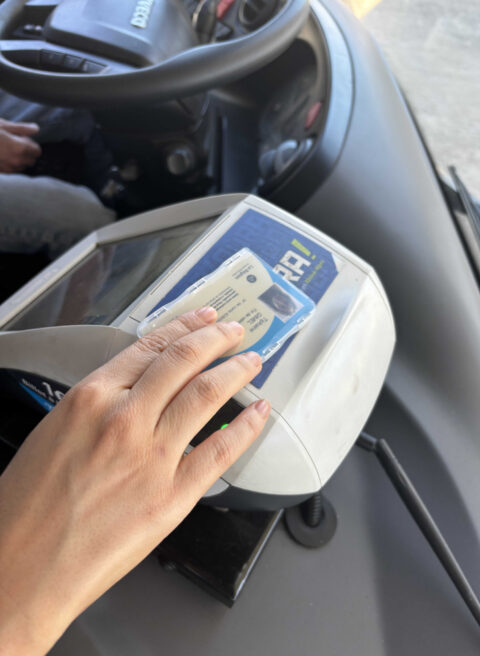
Yes, ridership has been steadily increasing for several years: from 302,000 boardings in 2019, before the pandemic, to 342,000 in 2023. Despite the challenges of the post-Covid period, growth continues thanks to ongoing efforts by the team and drivers to improve the network. We’re proud to have launched, for the first time in Ardèche, an urban transport network that improves access to public services and key locations. Feedback from users and neighboring communities has been very positive. To encourage usage, we’ve improved passenger information through better signage, clearer stops, and mobile apps like Hubup.
Have you seen an increase in ridership over the past three years ?
What feedback have you shared with other communities regarding Tout’enbus ?
With Aurélien’s help, we’ve integrated new technologies, making information more accessible and improving usability. Complaints have dropped by 99%, from about 10 per day to almost none—replaced by positive feedback. Punctuality improves year after year, and tools like the Hubup app are especially reassuring for parents, who can track their children’s bus rides in real time.
Thank you, Johan, for sharing your experience, and thanks to the Tout’enbus team for their trust !
We wish you a smooth journey ahead.
We’ve served as a reference for other local authorities, as well as our long-standing operator, Autocars Ginhoux, which had no experience with urban networks before Tout’enbus.
